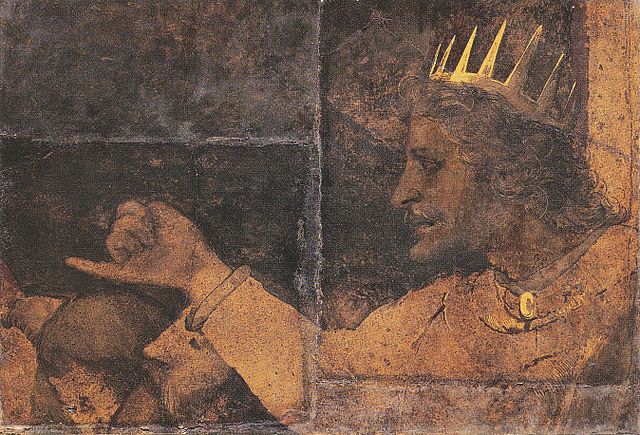
Rahab and the Emissaries of Joshua, artist unknown
Rachav, whose name is archaically transliterated as Rahab, appears in Canto IX of Paradiso, in the Third Sphere (Venus):
Know that within there Rahab is at peace;
And having joined our order she bestows
Her seal upon it in the loftiest place.
To this heaven, where the shadow your earth throws
Comes to a point, first soul to be retrieved
Of any, she with Christ triumphant rose;
And meet it was that she should be received
In some heaven, palm of victory supreme
That was with those two nailed palms achieved,
Because in Joshua’s war she prospered him
Toward his first glory in the Holy Land,
Which to the Papal memory is grown dim.
Rachav was a prostitute who assisted Yehoshua (Joshua) and his forces when they entered the Land of Israel and fought the Battle of Jericho. She hid the two spies sent by Joshua, under flax bundles on her roof. Before they fled, the spies promised to spare her and her family after capturing Jericho. They gave her instructions to hang a red cord from her window so they’d know which house to spare. According to legend, she later became a member of the tribe and married Joshua.
The rabbis were absolutely fascinated with Rachav, calling her one of the four most beautiful women to ever live (along with Sarah, Queen Esther, and King David’s third wife Avigayil). There’s a rather strange, off-color story in the Talmud, where Rabbi Nachman asks Rabbi Yitzchak to speak some words of Torah. Rabbi Yitzchak comes out with a rather unexpected story about how Ya’akov (Jakob) never really died, and then gets even weirder by saying anyone who says Rachav’s name twice will automatically ejaculate. Rabbi Nachman says he didn’t ejaculate by saying her name, and Rabbi Yitzchak says it only happens to men who saw her face-to-face.
Rachav means “spacious” or “wide.”

Fragment of the wall painting in the Great Council Chamber of Basel Town Hall, by Hans Holbein the Younger
Rechovoam was the fourth King of Israel, according to the Biblical account. He was proceeded by his famous father Shlomo (Solomon), and his mother was Na’ama, the only one of Shlomo’s wives mentioned by name. Conventional Biblical chronology places his reign in the mid-10th century before the Common Era. His reign is described in I Kings and II Chronicles. According to the Bible, he was 41 when he ascended the throne.
Rechovoam went against his advisors and refused to grant any reforms to his father’s policies, reforms which would’ve reduced the royal purse and thus scaled down the court’s decadence. Instead he took the advice of the people he’d grown up around, who told him to tax the people even more heavily and to show no weaknesses.
The ten tribes in the north revolted against these harsh policies in 932/931 BCE, and formed their own kingdom. Rechovoam was left as king of only two tribes, Yehudah (Judah) and Binyamin (Benjamin). The two tribes merged into the Kingdom of Judah, and the kingdoms were constantly at war throughout Rechovoam’s 17 years on the throne. In the fifth year of his reign, he also had to deal with an Egyptian invasion.
Rechovoam had 18 wives and 60 concubines, who had 60 girls and 28 boys. It’s so refreshing to see far more girls than boys attributed to someone from ancient history or mythology! Usually we only see sons being born or listed, as though it’s impossible for anyone in heavily androcentric societies to have a baby with indoor plumbing.
Rechovoam appears in Canto XII of Purgatorio, as one of the people on the roadway up to the second level of Purgatory. His name is rendered in the dated transliteration Rehoboam.
O Rehoboam, here no threatening head
Your image shows; but a chariot now
Hurries you away, ere chase come, full of dread.
Rechovoam is derived from the Hebrew name Rechavam, which means “he enlarges the people.”

